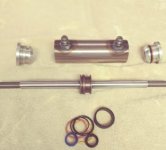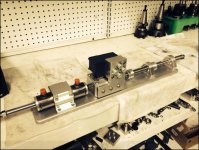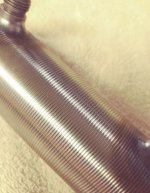With the coating, this was welded in place. First question... is induction hardened rod a requirement? Unless it is subjected to a steady flow of gravel, IH is probably not a requirement and will make the weld a LOT easier, as it's not going to harden on you and crack. We usually only saw induction hardened rods on the dirty end of excavators and other earth moving equipment. It's also hell to machine on the ends for eyes and piston threads. Usually heat a band where you want to machine so it anneals and works just like regular rod. If you can avoid the IH,do so.
As for how to weld it, that's a TIG job if I ever saw one. Make it a near shrink fit, just a few thou clearance and TIG it up. With that little clearance for it to draw and the concentrated heat of TIG, it's not going to move much and likely will not bent the rod at all. Also, gently grind the chrome off the rod at the weld. It's only about .003" thick or less, so pretty easy to remove with just a die grinder and sanding disc. That will prevent weld contamination.
I have seen pistons welded to rods, glands welded to tubes, all kinds of crazy stuff on proprietary cylinders. We were about the only shop around that would do that kind of work. Some of it was insane. We would build this kind of thing, spending dozens of hours cutting it apart, making rods, eyes, pistons, tubes, butts, glands, spend hours looking up seals, figuring how to build it and not melt the seals, get it all together and the owner would charge the customer $150. Wasn't like we were dying for work, either... we were slammed and spending two days doing this when there was a $5000 crane cylinder that just needed to be put together. Never understood it.





